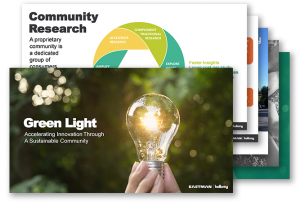Agile market research using online communities
It might seem like you are hearing the word “agile” every time you turn around these days. Perhaps we owe you an apology for writing yet another article about this often used (and often misused) term, but it’s time to set the record straight on a few things.
What started as a software development term is now being applied across industries, from publishing to construction, and from project management to (you guessed it!) market research.
The origins of agile
In the 90s, software development methods and ideology split. The historical, “heavyweight” methods were becoming too regulated, planned, and micro-managed, making way for a new “lightweight” school of thought. Several new “lightweight” methods evolved throughout the decade, culminating in the publication of the Agile Manifesto in 2001.
The manifesto states a set of values and accompanying principles that guide agile development. Specifically, agile development values:
- Individuals and interactions over processes and tools
- Working software over comprehensive documentation
- Customer collaboration over contract negotiation
- Responding to change over following a plan
The misuse of agile market research
There are three common misconceptions about agile, in the context of agile market research:
- It’s all about speed
- It’s cheap
- It’s okay to sacrifice quality to achieve #1 and 2
Yes, we at Bellomy agree that, when done well, agile market research tends to be faster and more affordable than traditional, ad hoc research. However, relaxing quality standards is not the answer. Instead true, effective agile market research depends on tighter project scoping, focused objectives, close collaboration, and iterative execution. At the end of the day, the benefits of speed and affordability in agile market research are secondary to the ultimate reduction of risk and waste — to use another buzzword, agile market research is sustainable.
Another way to think about agile
The most popular analogy for agile development found in Sideways Dictionary was submitted by Allen Coin:
"Agile development is like finishing a ship while at sea. You first get the minimum you need to make it float: a hull and maybe a mast. Then, instead of finishing it before you launch, you go ahead and launch it and finish building it while it’s at sea. This way you have to focus on the most important things.”
On the surface, given this definition, it’s not surprising that there are common misconceptions surrounding speed, affordability, and quality. After all, meeting the minimum requirements to float seems like a lower quality offering and takes a lot less time and funding than building the whole ship. However, this lens doesn’t properly account for the benefits of focusing on each component, in order of importance, building it right the first time, reducing waste and risk.
In order for research to support this development mindset, it must provide the right exploratory, decision-making, and confirmatory inputs at the right times to guide the completion of the ship. Individual research objectives towards that end goal might look something like:
- Explore: Now that we are afloat, what else should the ship to be able to do?
- Decide: Which of those features is the highest priority and should be built next?
- Explore: How should that feature work? What are all the benefits it provides?
- Decide: What is the best execution and communication of this new feature?
- Confirm: Is the new feature working as intended and providing the benefits communicated?
Online research communities: The answer to agile market research
Strong online research communities provide a solid foundation for conducting agile market research. Members are on-tap and pre-profiled, meaning you can talk to the right people (actual users and consumers), right away. Additionally, over time and with the right feedback and reinforcement, members provide better feedback. Counter to the belief that trained respondents are the enemy of good research, when community members know their voices are being heard and they understand the type of input needed, they become an incredibly valuable and reliable sounding board.
Finally, thinking back to the Agile Manifesto, effective online research communities provide a framework that fosters the core agile values:
- Research communities should provide a foundation of underlying process and tools that facilitate interactions between individuals.
- Stakeholders should not be bogged down in the details of execution (or comprehensive documentation). Instead they should be able to focus on activating the results creating the products and services that work for their customers.
- Contracts should typically be structured so that they encompass, not only the program stand-up, but also at least a year’s worth of research ensuring minimal contract negotiations and allowing us to collaborate freely with stakeholders based on their needs.
- Following best practices for panel and community engagement planning creates a schedule that is flexible and can respond to change as needed.
Getting started with agile market research
When you are looking to reduce risk as well as wasted time, insights, effort, and funds, you’re looking for agile market research. Agile market research won’t solve all your problems in a single study, but each set of insights will provide a clear path to the most important next step. Bellomy has over 40 years of experience in agile market research. Contact Bellomy to take the first steps with an online research community.
- research communities
Topics
We want to share our research community success story with you.
 Watch the webinar “How to Use an Online Community to Accelerate Innovation” on demand.
Watch the webinar “How to Use an Online Community to Accelerate Innovation” on demand.

